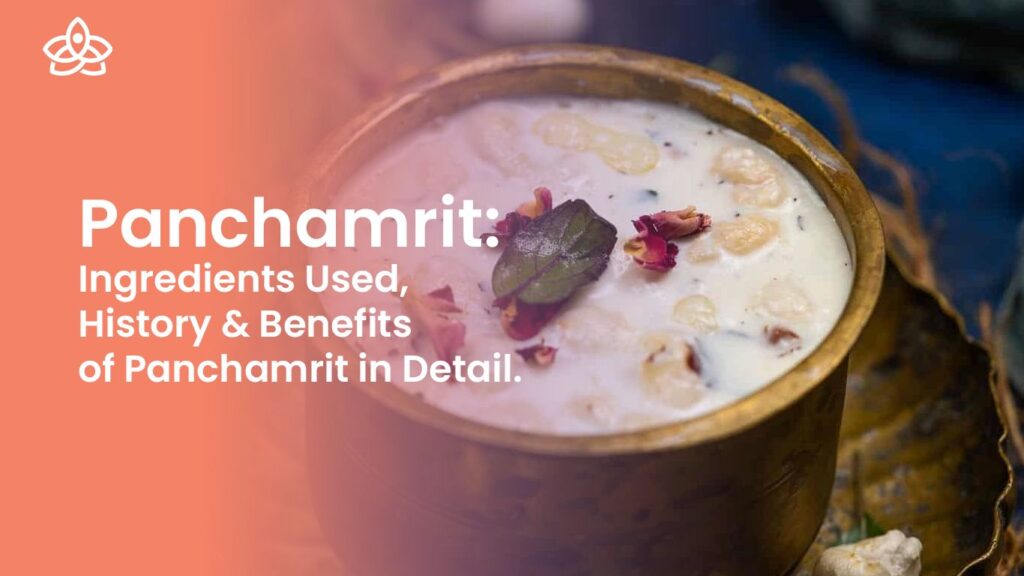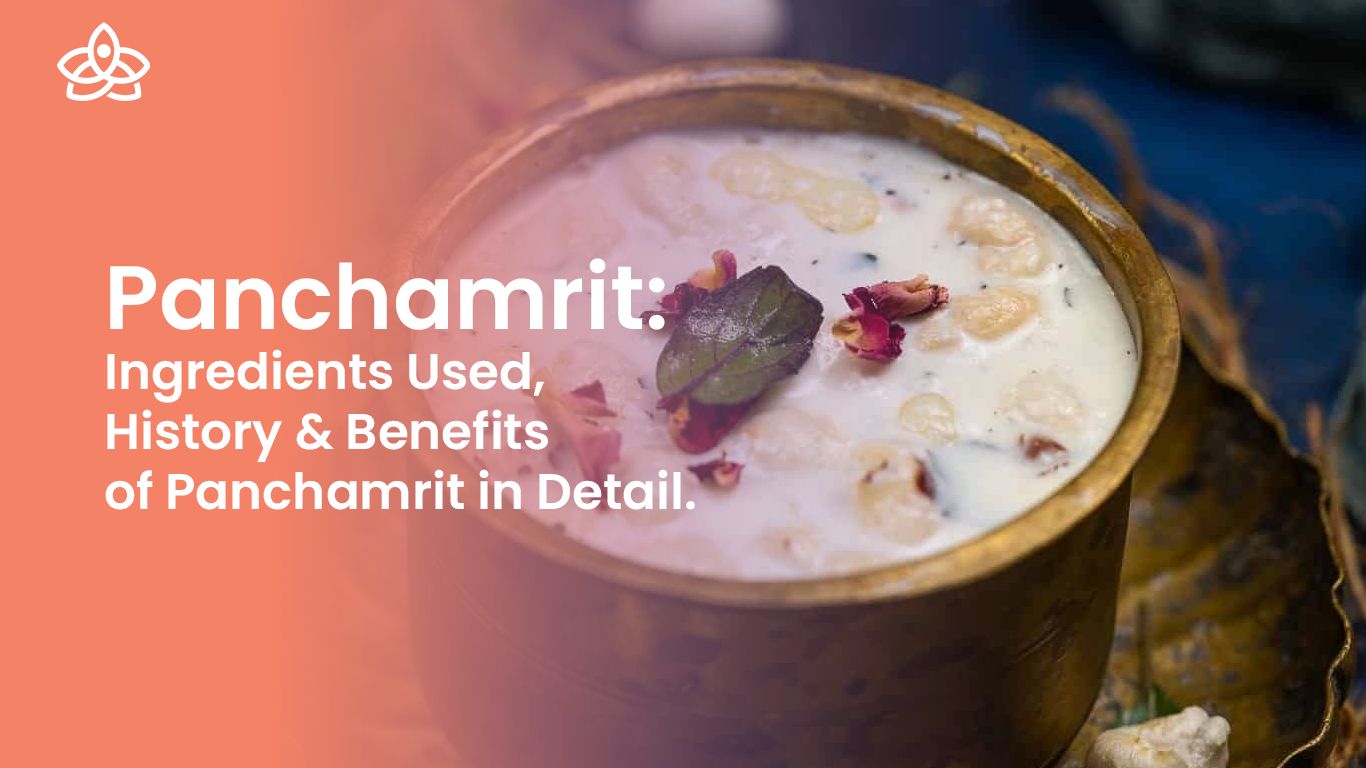Introduction to Panchamrit
The term Panchamrit is a combination of two Sanskrit words namely Panch and Amrit. Panch – means five, and Amrit – means nectar. It is made up of five key ingredients including cow milk, yogurt or curd, honey, sugar/jaggery for sweetener, and ghee.
According to Hindu mythology, the deities became immortal by drinking nectar which was known as Panchamrit. Panchamrit or Panchamrut is an Ayurvedic preparation, traditionally used in Hindu religious ceremonies like poojas. But in the modern days, it is prepared with different ingredients altogether, like, saffron, mint, bananas, coconut, dates, etc, which vary widely between religion, community, region, etc.

A Quick Overview of this Vedic Drink Panchamrit
The main component of an Ayurvedic mixture known as panchamrit, or panchamrut also known as charn Amrit, is made in the course of any Hindu ceremony or pooja. It is prepared using five ingredients known as panch amrut and is considered to be a sacred & sacramental drink. This drink was said to have come from Samundra Manthan. Mixing of only five ingredients used for the preparation of panchamrit enhances its quality and provides more effective outcomes. It is believed to be another medicine that feeds our body, makes it strong, and improves our immunity system. Also, it enhances hair growth and the quality of skin color.
Rudrabhishek, pooja of both Hindu and Jain based on this blend of five food ingredients of Panchamruta. it’s often used as prashada which is distributed in pooja. Variations of ingredients exist in preparing Panchamrit depending on different regions. It is a sweet mixture used in Hindu services, rituals and prayers called pooja. The name Panchamrit emanates from a Sanskrit word signifying the five and a half which could be interpreted as “five nectars of the gods” or, in a modern way,” immortal. Traditional recipes for this Vedic drink comprise five ingredients: Raw milk, natural honey, white sugar, ghee (made by self), and curd (yoghurt). Ordinarily, this food is usually provided to the deities and gods and eaten at the close of the puja or worshipping.
The other term may be also known as Charna Amrit (nectar from the feet of the gods or divine beings), but it means the water for the bath of Gods which is collected into a basin at the feet of the Gods. Meanwhile, all the ingredients of Panchamrit stand for symbolism. The elements of this culture include victories and strengths symbolized by ghee; prosperity through curd/yogurt; piety and purity with milk; and bliss and sweetness through sugar. Finally, Honey, in which bees cooperate so deeply signifies Unity and Sweet Speech. The second name of it could also be Charna Amrit or the divine nectar, a term applicable to the sacred water wash of god which gets collected into vessels at their feet. The divine beings took ambrosia which made them eternal according to Hindu folklore. Today, however, Panchamrit might include Tulshi leaf, saffron, banana, dates, coconut, and other ingredients which may vary depending on the region.
Origin of Panchamrit
The priest performs the final act of worship with ‘Panchmrit’, which is prepared and offered before the gods during the pooja ceremony.
The greatest reference to panchamrit can be traced to the Mahabharata greatest and as written. The story about this valuable ingredient is found in Mahabharata where it is said to have emerged in the course of Samundra Manthan or Ksheera Sagar Manthan. Every divine being involved in this fight had been trying their utmost best to be in control of this drink because of the understanding that whosoever will consume Panchamrit to the end of time will become immortal. In Hindu Mythology, each of the five main basic ingredients used for making sweet concoction has an appropriate symbolism. For instance- Milk is regarded as a symbol of piety and purity while honey is a symbol of unity and sweet speech. Sugar represents bliss and sweetness. As such, without the Panchamrit or Panchamrit Prasad, all the religious Hindu pujas and functions are considered incomplete. It is also used as a bhog prasad during poojas. Moreover, it is also used for performing abhishekam.
The following ingredients are used to make Panchamrit
- Cow milk
- Honey
- Sugar
- Ghee
- Dahi (Curd)
Advantages of Panchamrit
They also claim that it has medicinal properties that enhance the development of the body, and reinforce the immune system.
Many medics argue that it offers a lot of medical benefits. For instance; it is claimed to nurture the skin, promote safe pregnancy, and boost brain function. Moreover, it is also said to have medical qualities that nourish our body and heal us by making our immune system strong. It also improves hair and skin color.
Panchamrit has numerous health benefits and that is the reason why its name is ‘god food’. It is also given to a pregnant woman throughout nine months to ensure the well-being of both mother and baby. However, Panchamrit when mixed in the right quantity, is considered healthy for the brain and hence improves the brain system. However, it is reported that it provides nutrients for the skin, thereby making it appear healthy and bright. It also helps with good hair growth. Panchamrit is made up of five equal ingredients as per Ayurveda and their health benefits are immense when combined.
Listed below are seven Health Benefits of Panchamrit.
- Excellent for Bones.
- Strengthening our immunity system.
- Brain Function.
- Pregnancy and Prenatal Benefits.
- Energy.
- Skin and Hair Nourishment.
- Strengthening reproductive tissues.
Final Words
It is also used in Hindu worship and pujas with a sweet called Panchamrit. The name comes from the Sanskrit, Pancha, signifying “five,” and Amrit, signifying “interminable” or “nectar of the divine beings.” Traditional recipes for Panchamrit comprise five fixings: Raw cow milk, curd (yogurt), honey, sugar, and ghee. Normally, Panchamrit is given as prasad and is taken at the end of worshipping or after puja. Similarly, Panchamrit may be called Charna Amrit (nectar from the feet of the gods), although this name also refers to water that collects in bowls at the feet of gods during washing. As per the Hindu fables, the gods became immortal by consuming Panchamrit. Panchamrit which is not traditionally used usually comprises Tulsi leaf, saffron, bananas, dates, coconuts, and others as they are dependent on the district.



